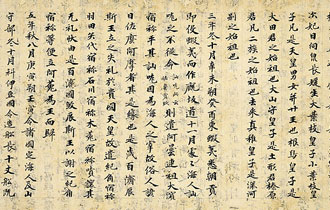Pages |
Mizoguchi's critics too have done their best to elucidate "the art part" of these classics. But what of the audience itself? Has enough been done to help non-Japanese viewers see all that there is to see? After all--as the need for subtitles itself suggests--viewing in such a case calls for a kind of "reading" too. Not of course just dialogue translated, but all manner of cultural specificities must be translated as well. That has been my mission for decades in the classroom, and in a number of books and articles: to help audiences "read" Japanese cinema. Like any skill, this one seeks ease in method--the critical one I have developed over the years, thanks to the patient enthusiasm of more students and colleagues than I can count.
Rashōmon (1950)
On September 7, 1998, Kurosawa Akira died of a stroke at his home in Tokyo. He was eighty-eight. The next day's New York Times obituary was one of the longest the paper had published in the last decade.
Its length alone was a fitting tribute to the scope of Kurosawa's achievement and the recognition it earned him at home and abroad. Film lovers East and West know him as the masterful director whose annus mirabilis was 1951. The judges at that year's Venice Festival awarded its Grand Prize to his Rashōmon. The film also won an Oscar for the best foreign-language picture of 1951. Thus, his tenth film, marked the beginning of the Golden age in Japanese cinema.
The film opens with ten rapid shots of a half-ruined gate, the Rashōmon, in the midst of a pour down. Then the priest at the gate says: "War, earthquakes, great winds, fires, famines, plague--each year is full of disaster."
Here Kurosawa counts very heavily on the Japanese audience's knowledge of their nation's history. The film is set in the ancient capital of Japan, Kyoto, in the twelfth century. The era marked Japan's transition from aristocracy to feudalism; it was a period characterized by civil wars. Moreover, Buddhist religious thinkers of that century believed that they were witnessing the final degenerate phase of the world. According to them, Buddhism would enter into the descending cycle known as the last phase of the Dharmic Law (mappō). This degeneration was evidenced by growing political strife and disorder, and in general the rapid disintegration of morals. So the ruined Rashōmon gate is a microcosmic representation of the political, religious and moral chaos that prevailed in twelfth-century Japan.
The word "Rashōmon" literally means the gate in which Ra (one of Devas) was born. When the Heian capital was originally built at the end of the eighth century, it served as a glorious southern entrance to the capital.
Thus the film starts with a keen awareness of the fragmented state of the world. However, the world is not utterly chaotic beyond redemption. The gargoyle and the signboard appear intact amid the devastation. The integrity of these two religious symbols implies that the fragmented world still holds out a potential for restoration. Kurosawa is a moralist whose premise of a tortured, fragmented world leads to a question demanding a committed inquiry, namely: 'Where is the basis for hope of renewal to be found?'
In fact, the film Rashōmon took its cues from two short stories by Akutagawa Ryūnosuke: "Yabu no Naka" (In the Grove) and "Rashōmon." A great deal has been written about Kurosawa's adaptation of these stories. Still, one can hardly mention his achievement without pausing to consider the sure touch he brings to adapting these two works.
Pages |











